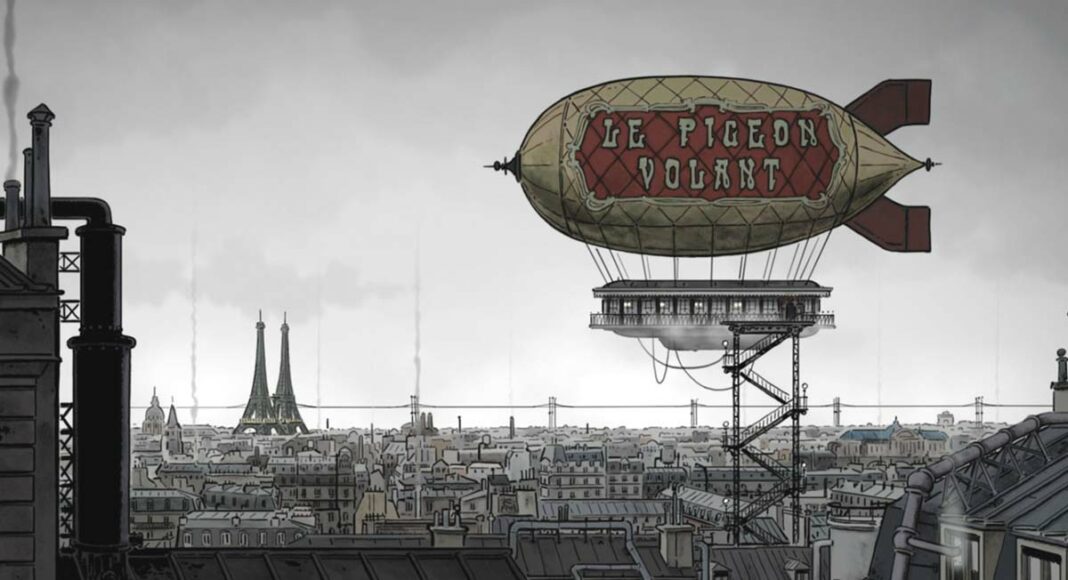Imagine an early 20th-Century world in which scientific progress has stopped. There are no trains or airplanes, no internal combustion engine, no electricity or telephones. Scientific innovation ended with steam and coal in the Victorian era, and scientists themselves are becoming an endangered species; they disappear with alarming frequency across the globe, leaving the world in a perpetual Age of Steam.
This is the steampunk fan’s paradise envisioned by filmmakers Christian Desmares and Franck Ekinci in their fanciful animated feature April and the Extraordinary World. Adapted from a popular graphic novel by French artist Jacques Tardi, the story combines the imaginative energy of old Twilight Zone episodes about an alternative Earth with a cautionary vision of eco-disaster, ingenious steampunk devices, and a tale of a plucky teenage girl who saves the day. Also: giant lizards from outer space. But the hand-drawn animation is lovely, and, somehow, it all works.
The movie radiates quaint period charm from the start, with opening credits displayed amid the accoutrements of a science lab: on the labels of glass specimen jars and old-fashioned card catalogs, on the pages of notebooks and the spines of three-ring binders, scrawled across a chalkboard. In a flashback to 1870, on the eve of the Franco-Prussian War, an unfortunate encounter between Emperor Napoleon III and the scientist he’s charged with creating an “Invulnerability Serum” to make his troops invincible ends in disaster. The good news is that the war never happens. The bad news is that scientific exploration ends, and the world is “stuck in the Steam Age.”
The story proper begins in 1931. Prosper, son of the original scientist, now a grandfather himself, his adult son, Paul, and his wife, Annette, are still trying to create the serum, in secret. Their experiments have had some interesting results—like investing the pet cat, Darwin (voice of Tony Hale), of their little daughter, April, with the power of speech. But just when they’re on the verge of discovery, police led by the officious Pizoni (Paul Giamatti) break up their secret lab. Her grandfather is chased off into the night, while April sees her parents disappear into a sinister black cloud of lightning.
Ten years later, in a time-warp Paris of 1941, April (Angela Galuppo) occupies a secret lair inside an enormous statue, scavenging the materials she needs to continue her parents’ work. Darwin the cat, her only companion, is now elderly, and she’s desperate to succeed—and she does. Soon enough, she and the revitalized Darwin are on the run, accompanied by street kid Julius, with his own agenda, pursued again by the vengeful Pizoni, and once again attracting the notice of the forces behind the black cloud—determined to eliminate scientific discovery from the human world.
This retro-Paris is charmingly depicted, with its dirigibles, air cable-cars, steam-powered autos, and twin Eiffel Towers. But the constant burning of coal for heat coats everything with a toxic layer of soot and grime; gas masks are required to venture outside, and there’s only one tree left in the city. No wonder mysterious forces are dead-set against allowing humans access to any more technology.
The story drags a bit in the third quarter. (A fleet 90-minute running time would have been about perfect.) A little of hapless antagonist Pizoni, huffing and puffing along in the kids’ wake, goes a very long way. And the relationship of April and Julius evolves along pretty standard juvenile romance lines, as bickering and misunderstanding lead to grudging respect and alliance.
But wry humor permeates everything. (“Once again, the Imperial Army was almost victorious!” exults one headline.) There’s playfulness in the juxtaposition of the cold, gear-driven world outside and the comfy, hidden Victorian house with overstuffed furniture and Victrola where April reunites with her grandfather. (And look for the Metropolis reference at the steam-generating center!)
Darwin, the cat, is a fun character. Besides, you know, the talking thing, Darwin behaves exactly like any other feline, drawn and animated to replicate slinky, nonchalant cat moves in every frame. For all its other charmingly outré marvels, he’s the furry little engine that drives the movie.
APRIL AND THE EXTRAORDINARY WORLD
*** (out of four)
A film by Christian Desmares and Franck Ekinci. Based on the graphic novel by Jacques Tardi. A Gkids release. Rated PG. 105 minutes.












